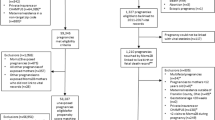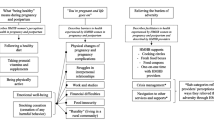Abstract
Objectives To describe temporal changes in maternal and child health outcomes in an impoverished urban community after the implementation of an innovative community-based pregnancy support program, named Moms2B. Methods Beginning in 2011, pregnant women in an urban impoverished community were recruited for participation in a community-based pregnancy support program focused on improving nutrition coupled with increasing social and medical support. The comprehensive program targeting pregnancy through the infants’ first year of life was developed and staffed by a multidisciplinary team from an academic health system. As a preliminary effort to assess the effectiveness of Moms2B, we examined maternal and infant health characteristics in the community before and after implementation of the program. Results From 2011 to 2014, 195 pregnant women attended one or more Moms2B sessions at the Weinland Park (WP) location. Most (75%) were African American (AA) with incomes below $800 per month and significant medical and social stressors. Outcomes from the two WP census tracts before and after implementation of the Moms2B program were studied. From 2007 to 2010, there were 442 births in WP and 6 infant deaths for an infant mortality rate of 14.2/1000. In 2011–2014, the first four years of the Moms2B program there were 339 births and one infant death giving an IMR of 2.9/1000, nearly a five-fold reduction in the rate of an infant death. Among pregnant women in WP who were covered by Medicaid, the breastfeeding initiation rate improved from 37.9 to 75.5% (p < .01) after the introduction of Moms2B. There were no infant deaths among Moms2B participants at the WP location in the first four years of the program. Conclusions Implementation of an innovative community-based pregnancy support program was associated with important improvements in maternal and infant health in an impoverished neighborhood.
Similar content being viewed by others
References
Ansell, D. A., & McDonald, E. K. (2015). Bias, black lives, and academic medicine. New England Journal of Medicine, 372(12), 1087–1089.
Bassett, M. T. (2015). #BlackLivesMatter–a challenge to the medical and public health communities. New England Journal of Medicine, 372(12), 1085–1087.
Behrman, R. E., & Butler, A. S. (2007). Preterm birth: Causes, consequences, and prevention. Washington DC: National Academies Press.
Carlberg, M. M., Shapiro-Mendoza, C. K., & Goodman, M. (2012). Maternal and infant characteristics associated with accidental suffocation and strangulation in bed in US infants. Maternal and Child Health Journal, 16(8), 1594–1601.
Chen, A., & Rogan, W. J. (2004). Breastfeeding and the risk of postneonatal death in the United States. Pediatrics, 113(5), e435–e439.
Christiaens, I., Hegadoren, K., & Olson, D. M. (2015). Adverse childhood experiences are associated with spontaneous preterm birth: A case-control study. BMC Medicine, 13, 124. doi:10.1186/s12916-015-0353-0.124-0353.
City of Columbus Department of Development. (2008). Weinland Park neighborhood plan. Columbus, OH. Retrieved, from http://campuspartners.osu.edu/assets/documents/WeinlandParkPlan.pdf.
Columbus Public Health. (2016). Ohio Department of Health 2013–2014 Vital Statistics Data: Weinland Park Demographics.
Cook, J. T., Black, M., Chilton, M., Cutts, D., Ettinger de C. S., Heeren, T. C., Frank, & D. A. (2013). Are food insecurity’s health impacts underestimated in the U.S. population? Marginal food security also predicts adverse health outcomes in young U.S. children and mothers. Advances in Nutrition, 4(1), 51–61.
Detres, M., Lucio, R., & Vitucci, J. (2014). GIS as a community engagement tool: Developing a plan to reduce infant mortality risk factors. Maternal and Child Health Journal, 18(5), 1049–1055.
DeVol, P., Payne, R. K., & Smith, T. D. (2006). Bridges out of poverty: Strategies for professionals and communities workbook. Highlands, TX: Aha! Process, Inc.
Englund-Ogge, L., Brantsaeter, A. L., Sengpiel, V., Haugen, M., Birgisdottir, B. E., Myhre, R., Meltzer, H. M., & Jacobsson, B. (2014). Maternal dietary patterns and preterm delivery: Results from large prospective cohort study. BMJ. doi:10.1136/bmj.g1446.
Felitti, V. J., Anda, R. F., Nordenberg, D., Williamson, D. F., Spitz, A. M., Edwards, V., & Marks, J. S. (1998). Relationship of childhood abuse and household dysfunction to many of the leading causes of death in adults: The adverse childhood experiences (ACE) Study. American Journal of Preventative Medicine, 14(4), 245–258.
Forste, R., Weiss, J., & Lippincott, E. (2001). The decision to breastfeed in the United States: Does race matter? Pediatrics, 108(2), 291–296.
Harris, P. A., Taylor, R., Thielke, R., Payne, J., Gonzalez, N., & Conde, J. G. (2009). Research electronic data capture (REDCap)-a metadata-driven methodology and workflow process for providing translational research informatics support. Journal of Biomedical Informatics, 42(2), 377–381.
Ickovics, J. R., Reed, E., Magriples, U., Westdahl, C., Schindler, R. S., & Kershaw, T. S. (2011). Effects of group prenatal care on psychosocial risk in pregnancy: Results from a randomised controlled trial. Psychology & Health, 26(2), 235–250.
Kramer, M. R., & Hogue, C. R. (2009). What causes racial disparities in very preterm birth? A biosocial perspective. Epidemiologic Reviews, 31(1), 84–98. doi:10.1093/AJEREV/MXP003.
Love, C., David, R. J., Rankin, K. M., & Collins, J. W. Jr. (2010). Exploring weathering: Effects of lifelong economic environment and maternal age on low birth weight, small for gestational age, and preterm birth in African–American and white women. American Journal of Epidemiology, 172(2), 127–134.
Lu, M. C., Kotelchuck, M., Hogan, V., Jones, L., Wright, K., & Halfon, N. (2010). Closing the black-white gap in birth outcomes: A life-course approach. Ethnicity & Disease, 20(1), S62–S76.
Lu, M. C., & Lu, J. S. (2007). Maternal nutrition and infant mortality in the context of relationality. Washington, DC: Joint Center for Political and Economic Studies Health Policy Institute.
Luke, B., & Brown, M. B. (2006). The changing risk of infant mortality by gestation, plurality, and race: 1989–1991 versus 1999–2001. Pediatrics, 118(6), 2488–2497.
Lundahl, B., Moleni, T., Burke, B. L., Butters, R., Tollefson, D., Butler, C., & Rollnick, S. (2013). Motivational interviewing in medical care settings: A systematic review and meta-analysis of randomized controlled trials. Patient Education and Counseling, 93(2), 157–168.
March of Dimes. (2016). PeriStats. White Plains, NY. Retrieved, from http://www.marchofdimes.org/peristats/Peristats.aspx.
Matthews T. J., MacDorman, M. F., & Thoma, M. E. (2015). Infant mortality statistics from the 2013 period linked birth/infant death data set. National Vital Statistics Report, 64(9), 1–30.
Meis, P. J., & Connors, N. (2004). Progesterone treatment to prevent preterm birth. Clinical Obstetrics and Gynecology, 47(4), 784–795.
Ohio Department of Health (2015). 2014 Ohio infant mortality data: General findings. Columbus, OH. Retrieved, from http://www.odh.ohio.gov/~/media/ODH/ASSETS/Files/cfhs/Infant%20Mortality/2013%20Ohio%20Infant%20Mortality%20Data%20Report%20FINAL.pdf.
Olds, D. L. (2006). The nurse-family partnership: An evidence based preventive intervention. Infant Mental Health Journal, 27, 5–25.
Person, M. K., Esposito, D. H., Holman, R. C., Mehal, J. M., & Stoll, B. J. (2014). Risk factors for infectious disease death among infants in the United States. The Pediatric Infectious Disease Journal, 33(11), e280–e285.
Petrou, S., Eddama, O., & Mangham, L. (2011). A structured review of the recent literature on the economic consequences of preterm birth. Archives of Disease in Childhood – Fetal and Neonatal Edition, 96(3), F225–F232. doi:10.1136/adc.2009.161117.
Petrou, S., Sach, T., & Davidson, L. (2001). The long-term costs of premature birth and low birth weight: results of a systematic review. Child: Care, Health and Development, 27(2), 97–115. doi:10.1046/j.1365-2214.2001.00203.x.
Rawlings, J. S., Rawlings, V. B., & Read, J. A. (1995). Prevalence of low birth weight and preterm delivery in relation to the interval between pregnancies among white and black women. New England Journal of Medicine, 332(2), 69–74.
Redding, S., Conrey, E., Porter, K., Paulson, J., Hughes, K., & Redding, M. (2015). Pathways community care coordination in low birth weight prevention. Maternal and Child Health Journal, 19(3), 643–650.
Spong, C. Y., Iams, J., Goldenberg, R., Hauck, F. R., & Willinger, M. (2011). Disparities in perinatal medicine: Preterm birth, stillbirth, and infant mortality. Obstetrics and Gynecology, 117(4), 948–955.
Stein, J. A., Lu, M. C., & Gelberg, L. (2000). Severity of homelessness and adverse birth outcomes. Health Psychology, 19(6), 524–534.
Sullivan, S. (2014). Weinland Park rebuilds after decades of gang violence. Columbus monthly. Retrieved, from http://www.columbusmonthly.com/content/stories/2014/10/weinland-park-rebuilds-after-decades-of-gang-violence.html.
Wegman, M. E. (2001). Infant mortality in the 20th century, dramatic but uneven progress. The Journal of Nutrition, 31(2), 401S-408S.
Weinland Park Collaborative. (2013). Weinland Park collaborative: Status report. Columbus, OH. Retrieved, from http://campuspartners.osu.edu/assets/documents/WPC%20progress%20report%20-%20FINAL%20SMALL%20EMAIL%20with%20appendice.pdf.
Acknowledgements
The authors wish to acknowledge the contributions and assistance of Dr. Steven Gabbe and to our community partners. Core partners include: Mount Carmel Health, Columbus Public Health Department, the Center for New Directions, a career development center, the American Red Cross, which provided transportation, the Columbus Community Foundation, the Chase Foundation, the Kroger Company, the United Way, the Kiwanis’s club, CareSource Foundation, and the Weinland Park Collaborative to enhance economic, health, and social development in Weinland Park.
Author information
Authors and Affiliations
Corresponding author
Rights and permissions
About this article
Cite this article
Gabbe, P.T., Reno, R., Clutter, C. et al. Improving Maternal and Infant Child Health Outcomes with Community-Based Pregnancy Support Groups: Outcomes from Moms2B Ohio. Matern Child Health J 21, 1130–1138 (2017). https://doi.org/10.1007/s10995-016-2211-x
Published:
Issue Date:
DOI: https://doi.org/10.1007/s10995-016-2211-x




